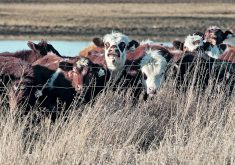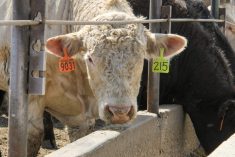Federal and provincial animal health officials have confirmed the arrival of highly pathogenic avian influenza on a commercial poultry operation in Manitoba, making it the seventh province so affected.
The provincial ag ministry said Sunday that the Canadian Food Inspection Agency had confirmed high-path H5N1 avian flu in a commercial flock in the RM of Whitemouth, which is about 100 km east of Winnipeg, south of Pinawa.
The province and CFIA didn’t say Sunday what kind of birds or how many were affected in the outbreak. The Whitemouth case marks Manitoba’s first such case in commercial poultry in high-path H5N1’s current run through North America; the virus was recently seen in samples taken from wild birds in the province’s west.
Read Also

U.S. livestock: Cattle regain losses, hogs rise
Chicago cattle futures rose on Tuesday, recouping losses from Monday’s screwworm scare. Lean hog futures also rose.,.
Since our most recent previous report on this website on Thursday, CFIA has also confirmed the following high-path avian flu outbreaks in Canada:
- three commercial poultry flocks in central and southern Alberta — in Wetaskiwin, Rocky View and Camrose counties, confirmed Thursday, Saturday and Sunday, respectively — plus a non-commercial small flock confirmed Thursday in Sturgeon County, just north of Edmonton;
- two more commercial poultry flocks in western Saskatchewan — one in the RM of Morse, on the south side of Lake Diefenbaker, about 70 km east of Swift Current, confirmed Friday, and one in the RM of Carmichael, between Shaunavon and Gull Lake, confirmed Sunday — plus a small non-commercial flock in the RM of Loreburn, on the east side of Lake Diefenbaker, confirmed Friday; and
- a non-commercial small flock in Peterborough County in southern Ontario, confirmed Saturday.
CFIA didn’t specify Sunday what subtype of high-path avian flu was seen in the Saskatchewan cases, but the new Alberta and Ontario cases were listed as high-path H5N1.
In all those cases, the infected premises have been placed under quarantines, CFIA said, adding it will set up “movement control measures” in the surrounding areas.
The new cases bring the total of avian flu outbreaks in commercial Canadian poultry flocks so far this year to 40, across seven provinces: 15 in central and southern Alberta, 14 in southern Ontario, four in Quebec’s Estrie, three in western Saskatchewan, two in western Nova Scotia and one each in B.C.’s Okanagan and eastern Manitoba.
CFIA also continues setting up primary control zones (PCZs) surrounding infected premises, in which all movement of domestic birds and poultry products — whether in, out or through — is “strictly controlled” and requires CFIA permits. As of Sunday, CFIA had officially set up 34 PCZs across the country.
Each of the 10 provinces has also now confirmed cases of avian flu in wild birds and/or non-commercial or backyard flocks in this latest run of high-path avian flu through Canada.
As of April 21, CFIA has put the estimated number of commercial and non-commercial domestic birds affected by avian flu in Canada this year at about 717,000.
Further south, the U.S. Department of Agriculture’s Animal and Plant Health Inspection Service (APHIS) since February has confirmed high-path avian flu in commercial poultry and/or backyard flocks in 29 states, including six on the Canadian border.
As of April 16, such cases have so far been found in Colorado, Connecticut, Delaware, Idaho, Illinois, Indiana, Iowa, Kansas, Kentucky, Maine, Maryland, Massachusetts, Michigan, Minnesota, Missouri, Montana, Nebraska, New Hampshire, New York, North Carolina, North Dakota, Ohio, Pennsylvania, South Dakota, Texas, Utah, Virginia, Wisconsin and Wyoming.
Risk level
Manitoba Agriculture, in its release Sunday, emphasized the risk of avian flu to human health is low and there’ve been no known cases of transmission of H5N1 from birds to people in North America.
In the rare cases where people catch avian flu, CFIA has said, it’s most likely to have been transmitted via close human contact with live infected birds, or in “heavily contaminated” environments.
H5N1 also does not pose a food safety risk, Manitoba Agriculture said, adding that poultry and eggs are safe to eat when proper handling and cooking take place.
The province reiterated Sunday that small or backyard flocks are considered at particular high risk for high-path avian flu infection as they often have access to outdoor pens or free range, meaning contact with infected wild birds is more likely.
Commercial poultry farmers, meanwhile, are “strongly urged to follow strict biosecurity protocols including precautions with farm visitors and service companies.”
The province also asked Manitoba residents to call the provincial toll-free TIP Line (1-800-782-0076) if they find any clusters of six or more dead wild waterfowl; any number of dead raptors or scavenger birds; or any other species of dead birds in groups of 20 or more.
If a dead bird has to be handled, gloves should be worn and the dead bird placed in a plastic bag, the province said. People should not touch dead birds or other wildlife with their bare hands; protective eyewear and masks are also recommended, and hands should be thoroughly washed before and after with soap and water or alcohol-based hand sanitizer. — Glacier FarmMedia Network
















